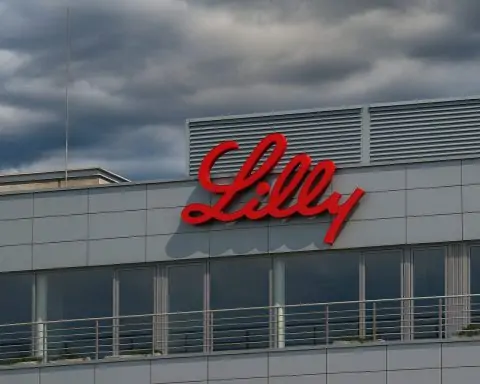The IRS announced inflation-adjusted 2026 tax brackets and deductions, easing bracket creep [1] [2]. For example, a single earner making $50,000 will now fall in the 12% bracket (instead of 22%) [3]. The standard deduction rises to $32,200 for joint filers ($16,100 single) [4]. All seven marginal rates (10%–37%) remain in force under the new law, but higher income cutoffs apply [5]. Capital gains thresholds also jump: the 0% rate applies up to ~$49,450 (single) or $98,900 (couples) [6], and the 15% bracket extends to ~$545,500/$613,700 [7]. These changes stem from the new “One Big Beautiful Bill” law (signed July 2025) that makes most 2017 TCJA tax cuts permanent and adds new deductions for workers and seniors. Importantly, no new stimulus checks are coming despite social-media rumors – the IRS and Congress have confirmed no October payment [8].
Meanwhile, U.S. markets are hitting record highs. On Oct. 8 the S&P 500 closed ~6,754 and the Nasdaq ~23,043 – both all-time highs [9] – fueled by an AI-fueled tech rally and Fed rate cuts [10] [11]. Gold also spiked past $4,000/oz on safe-haven buying. Wall Street insiders are split on the outlook: RBC raised its S&P 500 target to 6,250 by year-end 2025 (even projecting ~7,100 by end-2026) [12] and Goldman Sachs lifted its 2025 goal to ~6,800 [13], betting on a continued Fed-friendly environment. However, some experts warn this tech-driven rally could “eventually crest,” with valuations stretched [14] [15].
IRS Tax Brackets & Deductions for 2026: On Oct. 9, the IRS officially released the 2026 inflation adjustments [16]. The standard deduction increases about 2%: to $32,200 for married couples filing jointly (up from $31,500 in 2025) and $16,100 for singles [17]. Heads of household get $24,150. Crucially, all income brackets shift upward, meaning people can earn more before hitting the next rate. For instance, a single taxpayer earning $50,000 would now be taxed at 12% on the top portion, whereas that same income fell into the 22% bracket this year [18]. This “bracket creep” fix prevents inflation from pushing taxpayers into higher rates.
The marginal tax rates themselves remain unchanged at 10%, 12%, 22%, 24%, 32%, 35% and 37% [19]. The 37% top rate applies to single incomes above $640,600 (up from $626,350 for 2025) and $768,700 for joint filers [20]. Other thresholds also rose (for example, 35% now kicks in over $256,225 single and 22% over $50,400 single [21]). These figures come from the new one-time “One Big Beautiful Bill” Act (President Trump’s tax law enacted July 2025), which locked in and slightly adjusted the TCJA brackets.
Taxpayers should note that these 2026 bracket changes affect filings in 2027 (for the 2026 tax year) [22]. The IRS press release emphasizes that the inflation adjustments cover “more than 60 tax provisions,” providing relief to many filers [23]. As one tax expert explains, “you will have to earn more income next year before reaching a higher tax bracket” [24] – a boon for wage growth.
Capital Gains & Investment Taxes: The IRS also raised the income cutoffs for long-term capital gains brackets. The 0% capital gains rate now applies to married couples with taxable income up to about $98,900 (up from $96,700 in 2025), or $49,450 for singles [25]. Likewise, the threshold for the 15% rate moved higher: singles up to ~$545,500 (from $533,400) and joint up to ~$613,700 (from $600,050) [26] will pay 15% on gains. In short, the capital gains cutoffs rise roughly 2–3%, mirroring overall inflation adjustments. The top 20% federal gains rate (plus 3.8% NIIT surtax for high incomes) stays in place.
These changes ensure that more investment income can qualify for the 0% or 15% rates under the expanded brackets. (For example, previously a married couple could earn up to $96,700 in total income and still pay 0% on long-term gains; in 2026 that jumps to $98,900 [27].) The IRS’s adjustments mean fewer investors face higher tax bills just due to inflation.
Other Key Tax Updates: Several other provisions also shift upward. The Alternative Minimum Tax (AMT) exemption for 2026 is $90,100 for singles (phase-out starts at $500,000) [28]. The estate tax exclusion rises to $15.0 million per person (up from $13.99M) [29]. Meanwhile, Congress’s recent “One Big Beautiful Bill” introduced new deductions: for example, filers 65+ now get a temporary $6,000 deduction (on top of standard) if income is below certain limits [30]. The IRS fact sheet notes other new perks: workers can deduct up to $25,000 of tips and up to $12,500 of overtime pay (phasing out at $150K AGI) [31] [32], and even car loan interest on eco-friendly vehicles is deductible through 2028 [33]. These special rules aim to boost take-home pay for ordinary Americans.
No Stimulus Checks; Govt. Shutdown: All this news arrives in a tense political context. A partisan federal government shutdown began Oct. 1, 2025 (the first in seven years), furloughing hundreds of thousands of IRS workers and freezing non-essential services [34] [35]. Despite that, the IRS stressed that taxpayers must continue filing and paying taxes on time. A spokesperson told CBS News, “Taxpayers should continue to file, deposit, and pay federal income taxes as they normally would; the lapse in appropriations does not change Federal Income Tax responsibilities” [36]. (The IRS did note an agency-wide furlough from Oct. 8 as the shutdown dragged on [37].)
Amid shutdown buzz, a false rumor of an October stimulus check went viral online. TS2.tech reports that the IRS and federal officials flatly debunked these claims: “Taxpayers will not receive any new stimulus checks of any amount… Congress has not passed any 2025 stimulus package” [38]. The Associated Press confirmed with an IRS official that no $1,390 or $2,000 payments are coming, and warned that such social-media claims are scams [39]. In short, aside from the regular tax updates above, Americans won’t see any surprise government “free money” this fall.
Stock Market Reaction & Outlook: While tax news captured headlines, U.S. stock markets have been roaring. Equity indices hit fresh records just before Oct. 9. On Oct. 8, the S&P 500 jumped 0.6% to about 6,754 and the Nasdaq Composite rose 1.1% to ~23,043 – their highest closes ever [40]. The Dow Jones Industrial Average is similarly near record territory [41]. Fueling this rally is a potent mix of Fed policy and tech excitement. The Federal Reserve cut interest rates in September, and Fed minutes released Oct. 8 signaled most officials expect additional cuts soon [42]. Traders now put roughly 95% probability on a further 0.25% cut at the October meeting [43]. Lower borrowing costs are boosting stocks.
At the same time, the U.S. tech sector is surging thanks to an AI boom. For example, Advanced Micro Devices (AMD) announced a massive AI chip partnership with OpenAI on Oct. 6; its stock soared ~24% in one day to about $230 [44]. Nvidia, the AI-chip powerhouse, has rallied ~41% this year [45], pushing its market cap toward $4 trillion. Other AI and tech names are exploding: Oracle is up ~+73% and Palantir +143% in 2025 [46]. This broad technology frenzy is driving the Nasdaq’s gains and helping lift the S&P 500 despite high valuations. Even so, TS2.tech notes that historically, equity rallies usually cool off eventually – one strategist quipped that investors are treating the D.C. impasse “like a rerun” [47], and the Bank of England warned this week that tech-stock valuations appear “stretched” [48].
Gold is also at record highs, recently topping $4,000/oz on a flight to safety amid geopolitical and debt worries. The rare sight of both stocks and gold rallying together signals a “bifurcated market psychology,” according to one analyst [49]: on one hand bullish on innovation (AI, growth), on the other hand hedging against risks. As TS2.tech summarizes: “Optimism about innovation is driving equities higher even as undercurrents of worry drive gold to records” [50].
Expert Forecasts & Analysis: Analysts and economists offer mixed views. Many Wall Street strategists remain optimistic. For instance, RBC Capital Markets has raised its year-end 2025 S&P 500 target from 6,000 to 6,250 and even issued a preliminary 2026 target of 7,100 [51]. Goldman Sachs similarly lifted its 2025 forecast to ~6,800 [52]. They cite a “dovish Fed” (more rate cuts) and robust corporate earnings as reasons stocks can climb higher [53] [54]. Legendary economist Jeremy Siegel notes that “cooling inflation and a not-too-hot, not-too-cold economy are a recipe for the Fed to continue easing,” which should keep the bull market alive [55].
Others urge caution. Dakota Wealth strategist Robert Pavlik warns that “the market is still interested in the AI trade… it will eventually crest,” implying a future pullback [56]. RBC’s Eric Burns has noted that with the S&P 500 up ~18% YTD [57], forward earnings multiples are quite rich. TS2.tech analysts argue that a short-term 5–10% pullback at some point would be “healthy” given how fast indices have run [58]. Indeed, markets did pause briefly on Oct. 7 (after seven straight winning days), but quickly rebounded.
On the macro side, economists worry the shutdown could drag on. TS2.tech cites UMass economist Gerald Epstein, who warns a prolonged shutdown “almost certainly will be quite negative” for a fragile economy [59]. Shutdown-induced delays in jobs and inflation data mean the Fed is somewhat “flying blind” on policy [60] [61].
Bottom Line: For taxpayers, the takeaway is generally positive: higher brackets and deductions mean lower tax bills in 2026 for many Americans. Seniors and low-to-middle earners benefit most. However, political drama – from budget fights to economic headwinds – means vigilance is still needed. As one market commentator put it, “bull markets don’t die of old age; they die of policy mistakes or shocks” [62]. With the Fed signaling more cuts, inflation slowly cooling (Core PCE ~2.9% [63]), and tax relief baked in, stocks have room to run – at least for now. Investors will watch incoming Q3 earnings and political developments, but the current path is up. If history is a guide, a modest correction may come before year-end, but many analysts expect the U.S. equity rally to continue at least into 2026 [64] [65].
Sources: IRS and CBS News releases on 2026 tax adjustments [66] [67]; TS2.Tech financial analyses (Oct. 2025) on markets [68] [69] [70]; IRS official fact sheets [71]; TS2.Tech and AP market data [72] [73]; tax data tables [74] [75]; TS2.Tech interviews/quotes [76] [77]. (All figures are current as of Oct. 9, 2025.)
References
1. www.irs.gov, 2. www.cbsnews.com, 3. www.cbsnews.com, 4. www.irs.gov, 5. www.irs.gov, 6. thefinancebuff.com, 7. thefinancebuff.com, 8. ts2.tech, 9. ts2.tech, 10. ts2.tech, 11. ts2.tech, 12. ts2.tech, 13. ts2.tech, 14. ts2.tech, 15. ts2.tech, 16. www.irs.gov, 17. www.irs.gov, 18. www.cbsnews.com, 19. www.irs.gov, 20. www.irs.gov, 21. www.irs.gov, 22. www.irs.gov, 23. www.irs.gov, 24. www.cbsnews.com, 25. thefinancebuff.com, 26. thefinancebuff.com, 27. thefinancebuff.com, 28. www.irs.gov, 29. www.irs.gov, 30. www.cbsnews.com, 31. www.irs.gov, 32. www.irs.gov, 33. www.irs.gov, 34. ts2.tech, 35. ts2.tech, 36. www.cbsnews.com, 37. www.cbsnews.com, 38. ts2.tech, 39. ts2.tech, 40. ts2.tech, 41. ts2.tech, 42. ts2.tech, 43. ts2.tech, 44. ts2.tech, 45. ts2.tech, 46. ts2.tech, 47. ts2.tech, 48. ts2.tech, 49. ts2.tech, 50. ts2.tech, 51. ts2.tech, 52. ts2.tech, 53. ts2.tech, 54. ts2.tech, 55. ts2.tech, 56. ts2.tech, 57. ts2.tech, 58. ts2.tech, 59. ts2.tech, 60. ts2.tech, 61. ts2.tech, 62. ts2.tech, 63. ts2.tech, 64. ts2.tech, 65. ts2.tech, 66. www.irs.gov, 67. www.cbsnews.com, 68. ts2.tech, 69. ts2.tech, 70. ts2.tech, 71. www.irs.gov, 72. ts2.tech, 73. ts2.tech, 74. thefinancebuff.com, 75. thefinancebuff.com, 76. ts2.tech, 77. ts2.tech









